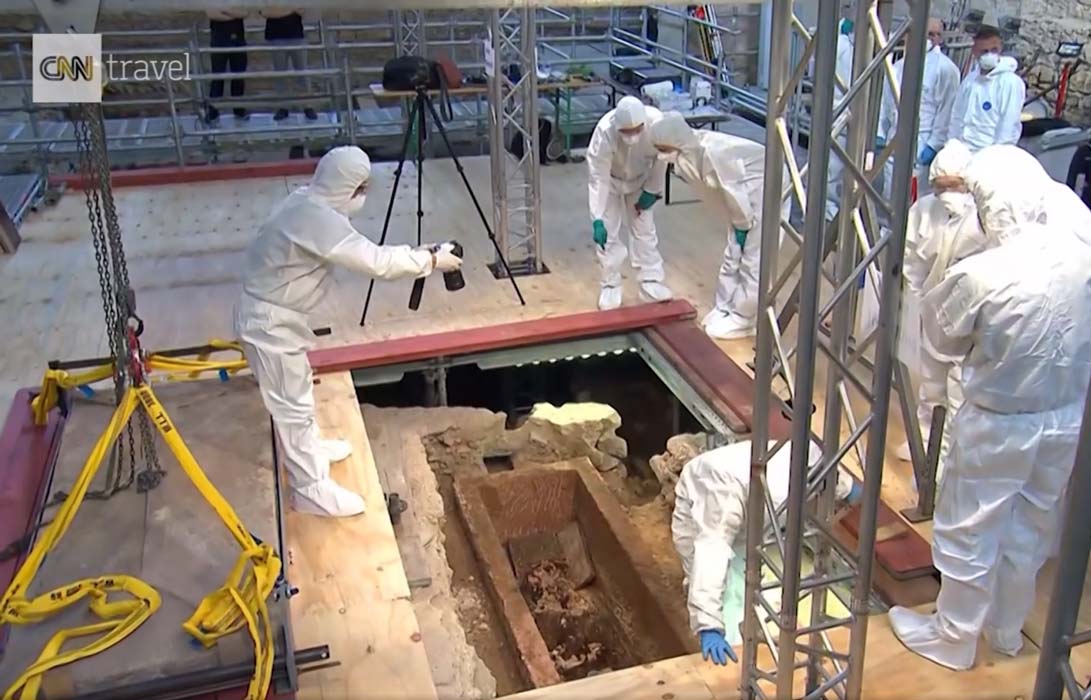1000-Year-Old Sarcophagus Discovered Beneath One of Germany’s Oldest Churches – Who’s Inside?
A 1,000-year-old sarcophagus discovered beneath a church floor in Mainz, Germany, is thought to hold the remains of a former 11th century Archbishop. Getting to the almost 1000-year-old skeleton took a multi-disciplined engineering task.
Buried beneath the floor of St. Johannis Church (Johanniskirche), one of the oldest in the city of Mainz, archaeologists identified the corner of the coffin in 2017 and undertook over a year of intricate preparations before excavating the ancient casket.
On 4 June, according to an article published in DW, the “14-strong team” used a complex pulley system to lift “the 700 kilogram (1,540 pound) lid off the grave” lead archaeologist Guido Faccani said "Such a long preparation time and then the lid opens," said, the "That was a unique moment. We quickly discovered that many scraps of fabric were present in the sarcophagus.”
The samples of fabric are being analyzed by a textile expert to determine their age. Bone and tissue samples will be dated and DNA tested. Faccani told reporters that “The bones of the individual buried in the sarcophagus were, however, completely decayed, not even teeth could be found” and he thinks this is because quicklime was thrown on the deceased to hurry his decomposition.
According to a CNN report, Volker Jung, the president of the Evangelical Church in Hessen and Nassau, described the opening of the coffin as a “very exciting, but also spiritually moving event.”
Additionally, the dean of Mainz, Andreas Klodt, told a news conference that everyone in the church “got to feel a little bit like Indiana Jones.” He added "So many generations of us have sung, doubted, prayed and hoped in this building, and I am proud that we have builders in this church and can celebrate Mass.”
Who on Earth Is Inside the Coffin?
The Roman Catholic faith was accepted in parts of Germany from the 5th century and in the 1200s, German Crusaders known as the Teutonic Knights had conquered pagan Prussia (Preußen) and successfully converted it to Catholicism, which remained the predominant faith of Germany until the 1500s, at which time the Reformation of Martin Luther and the Swiss religious reformers took effect.
The Johanniskirche is the oldest church in Mainz and it was taken over in 1828 by the Protestant community.
Because the individual was buried centrally in the nave of the church, “pointing towards the altar” the team of experts are inclined to believe the remains might belong to a clergyman, possibly Erkanbald, who was Archbishop of Mainz between AD 1011 and 1021. “It's still possible that it's him," Faccani said.” Erkanbald, of the family of the counts of Ölsburg was related to Bernard III of Sommerescheburg, Bishop of Hildesheim and for his part in the election of Henry IV, Duke of Bavaria, as King of Germany, Erkanbald who was at the time ‘abbot of Fulda’ was rewarded in AD 1011 with the ancient see of Mainz.

St. John's Church (in German Johanniskirche) in Mainz (CC by SA 3.0)
Spiritual Mechanics Don’t Come Cheap
When realizing death was imminent, medieval German folk got organized and prepared a budget for their afterlife, for it was believed that only in good preparation for death would your memory and post-mortem reputation be secured.
In the book, Cultures of Death and Dying in Medieval and Early Modern Europe, edited by Mia Korpiola and Anu Lahtinen, we learn “Imminent death made for a process called the “accounting of the afterlife” (la comptabilité de l’au-delà). Through the process of the “mathematics of salvation” (mathématique du salut), people assessed the necessary sums to be spent on pious causes (ad pios usus), including mass.
Erkanbald, if it is indeed him that has been discovered, would have been at the front end of this early capitalist experiment where churchmen took the hard cash of working folk for the forgiveness of their mortal sins. Not even he would have guessed that this the ploy would last almost one thousand years.
Top image: Scientists examining the inside of a 1,000-year-old sarcophagus in Mainz, Germany, after lifting the lid. Source: Print screen, CNN video.
By Ashley Cowie



















